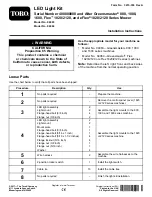
26
Important
Do not overfill the crankcase with oil
because the engine may be damaged.
1
2
3
Figure 21
1.
Oil dipstick
2.
Metal end
3.
Filler tube
Changing/Draining Oil
1. Start the engine and let it run five minutes. This warms
the oil so it drains better.
2. Park the machine so that the drain side is slightly
lower than the opposite side to assure the oil drains
completely. Then disengage the power take off (PTO),
set the parking brake, and turn the ignition key to
“OFF” to stop the engine. Remove the key.
3. Place a pan below the oil drain. Remove the oil drain
cap (Fig. 22).
4. When oil has drained completely, install the oil drain
cap.
Note: Dispose of the used oil at a certified recycling
center.
1
m-5204
Figure 22
1.
Oil drain cap
5. Slowly pour approximately 80% of the specified oil on
page 25, into the filler tube (Fig. 21). Now check the
oil level; refer to Checking Oil Level, page 25. Slowly
add additional oil to bring to “FULL” mark on
dipstick.
Change Oil Filter
Service Interval/Specification
Replace the oil filter every 200 hours or every other oil
change.
Note: Change oil filter more frequently when operating
conditions are extremely dusty or sandy.
1. Drain the oil from the engine; refer to
Changing/Draining Oil, page 26.
2. Remove the old filter and wipe the filter adapter
(Fig. 23) gasket surface.
3. Apply a thin coat of new oil to the rubber gasket on
the replacement filter (Fig. 23).
m–1256
1
2
3
Figure 23
1.
Oil filter
2.
Gasket
3.
Adapter
4. Install the replacement oil filter to the filter adapter.
Turn the oil filter clockwise until the rubber gasket
contacts the filter adapter, then tighten the filter an
additional 1/2 turn (Fig. 23).
5. Fill the crankcase with the proper type of new oil;
refer to Changing/Draining Oil, page 26.
Spark Plug Service
Service Interval/Specification
Check the spark plug(s) after every 200 operating hours.
Make sure the air gap between the center and side
electrodes is correct before installing the spark plug. Use a
spark plug wrench for removing and installing the spark
plug(s) and a gapping tool/feeler gauge to check and
adjust the air gap. Install a new spark plug(s) if necessary.
















































